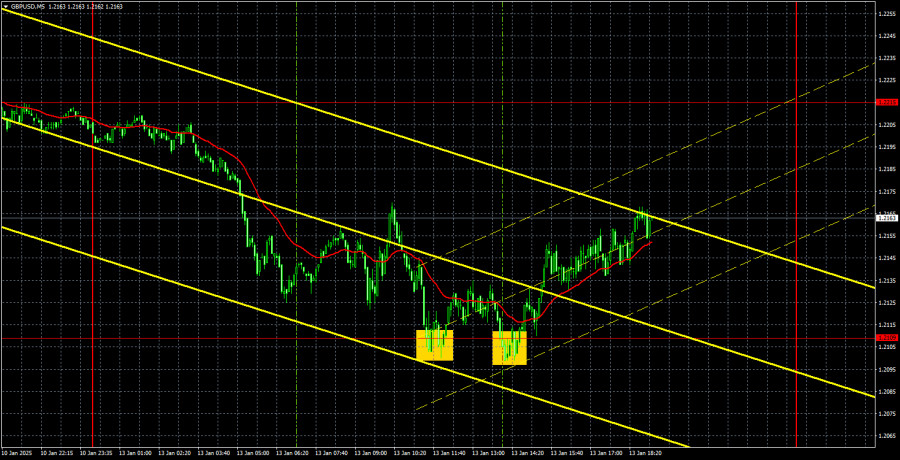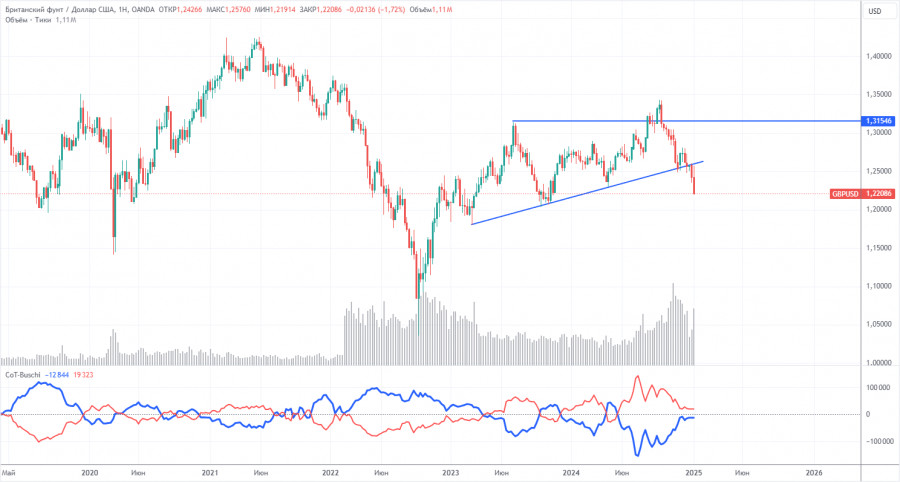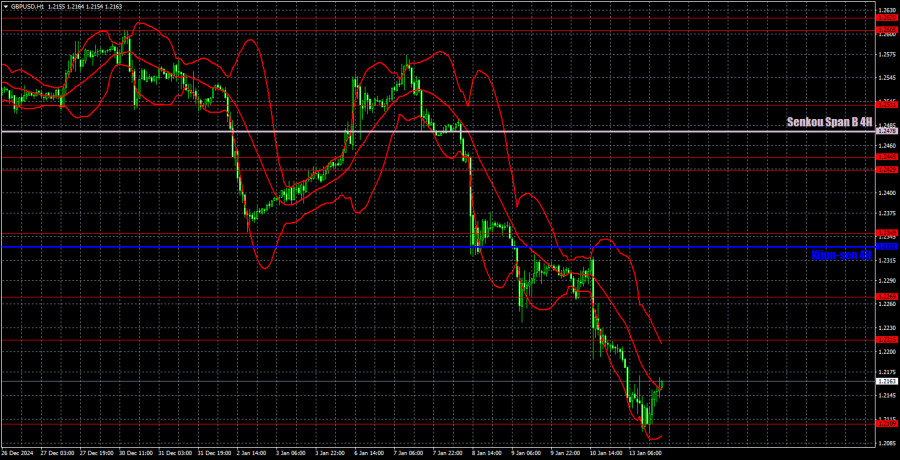GBP/USD 5-Minute Analysis
The GBP/USD pair continued its downward movement on Monday. Despite the absence of any reports from the UK or the U.S., the pound sterling depreciated by 110 pips during the first half of the day. The 1.2100 level was able to temporarily halt the decline, but the question remains: for how long?
The market's willingness to sell off the pound, even on days without local catalysts, indicates a distinctly bearish sentiment. This sentiment has persisted for three months, driven by well-known factors we have extensively discussed. While we may see a new correction beginning—potentially a strong one, as the daily timeframe suggests a need for a noticeable correction—it will not alter the overall trend. The pound remains firmly entrenched in a 16-year downtrend.
This week, the pound faces two significant tests: U.S. inflation and UK inflation. If U.S. inflation exceeds expectations and/or UK inflation slows or falls short of forecasts, the pound may quickly resume its steep decline. Conversely, positive data could support an upward correction.
On the 5-minute timeframe, two decent buy signals were generated on Monday. However, it raises the question: is it wise to buy during such a pronounced decline? These signals effectively mirrored each other and could have been traded, but we would not recommend taking such risks. It's better to miss a correction than to go against the trend, which could result in significant losses or lead to reliance on perpetual averaging. The pound could still plunge significantly lower.
COT Report
The latest Commitment of Traders (COT) report for the pound sterling highlights the fluctuating sentiment among commercial traders in recent years. The red and blue lines, representing the net positions of commercial and non-commercial traders, often cross each other and typically hover around the zero mark. Currently, these lines are close together, indicating a roughly equal number of long and short positions.
On the weekly timeframe, the price initially broke below the 1.3154 level and subsequently dropped further, breaching the trendline. This break suggests that the pound's decline is likely to continue in the long term.
According to the latest COT data, the non-commercial group opened 1,600 buy contracts and 100 sell contracts, resulting in a net position increase of 1,500 contracts. However, this does not indicate a positive outlook for the pound.
The fundamental backdrop does not provide any justification for long-term purchases of the pound. Instead, the currency appears to be on the verge of a renewed global downtrend. As a result, the net position may continue to decline, signaling further waning demand for the pound.
GBP/USD 1-Hour Analysis
On the hourly timeframe, the GBP/USD pair maintains a bearish outlook, with the most recent corrective move ending swiftly. There remains little reason for the pound to rise, except for the technical necessity of occasional corrections, a pattern that has been consistent week after week. In the medium term, we still anticipate further declines for the pound.
On January 14, we identify the following important levels: 1.2052, 1.2109, 1.2215, 1.2269, 1.2349, 1.2429-1.2445, 1.2511, 1.2605-1.2620, 1.2691-1.2701, 1.2796-1.2816, and 1.2863. The Senkou Span B (1.2478) and Kijun-sen (1.2332) lines may also provide trading signals. It is advisable to set the Stop Loss level at breakeven once the price moves 20 pips in the desired direction. Keep in mind that the Ichimoku indicator lines can fluctuate throughout the day, which should be considered when determining trading signals.
No major events are scheduled in the UK or the U.S. for Tuesday, aside from the Producer Price Index (PPI) in the U.S. However, we do not expect this report to attract significant interest from traders, especially with upcoming inflation reports from both the UK and the U.S. set to take precedence later this week.
Illustration Explanations:
- Support and Resistance Levels (thick red lines): Thick red lines indicate where movement may come to an end. Please note that these lines are not sources of trading signals.
- Kijun-sen and Senkou Span B Lines: Ichimoku indicator lines transferred from the 4-hour timeframe to the hourly timeframe. These are strong lines.
- Extreme Levels (thin red lines): Thin red lines where the price has previously bounced. These serve as sources of trading signals.
- Yellow Lines: Trendlines, trend channels, or any other technical patterns.
- Indicator 1 on COT Charts: Represents the net position size for each category of traders.

























